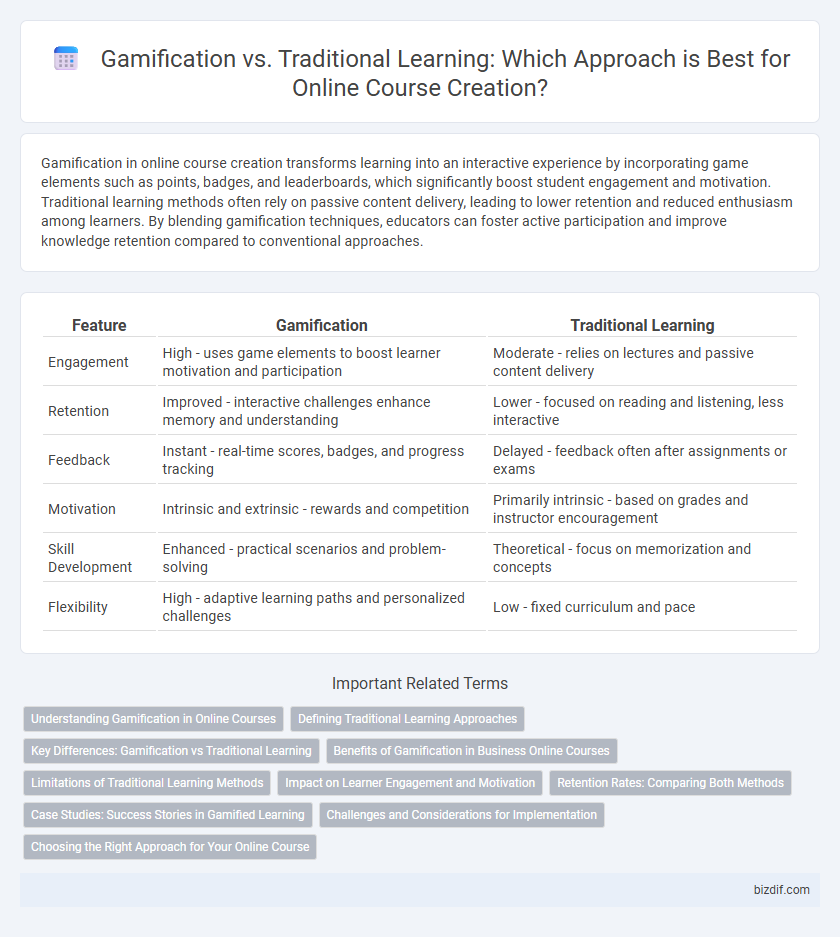Gamification in online course creation transforms learning into an interactive experience by incorporating game elements such as points, badges, and leaderboards, which significantly boost student engagement and motivation. Traditional learning methods often rely on passive content delivery, leading to lower retention and reduced enthusiasm among learners. By blending gamification techniques, educators can foster active participation and improve knowledge retention compared to conventional approaches.
Table of Comparison
| Feature | Gamification | Traditional Learning |
|---|---|---|
| Engagement | High - uses game elements to boost learner motivation and participation | Moderate - relies on lectures and passive content delivery |
| Retention | Improved - interactive challenges enhance memory and understanding | Lower - focused on reading and listening, less interactive |
| Feedback | Instant - real-time scores, badges, and progress tracking | Delayed - feedback often after assignments or exams |
| Motivation | Intrinsic and extrinsic - rewards and competition | Primarily intrinsic - based on grades and instructor encouragement |
| Skill Development | Enhanced - practical scenarios and problem-solving | Theoretical - focus on memorization and concepts |
| Flexibility | High - adaptive learning paths and personalized challenges | Low - fixed curriculum and pace |
Understanding Gamification in Online Courses
Gamification in online courses leverages game design elements like points, badges, and leaderboards to enhance learner engagement and motivation. This approach fosters active participation and improves knowledge retention compared to traditional learning methods, which often rely on passive content delivery. Integrating gamification strategies creates interactive and personalized experiences that drive higher course completion rates and learner satisfaction.
Defining Traditional Learning Approaches
Traditional learning approaches primarily involve instructor-led lectures, standardized assessments, and passive student participation within physical classroom settings. These methods often emphasize memorization, uniform pacing, and a one-size-fits-all curriculum structure. Such frameworks can result in limited learner engagement and reduced personalization compared to modern interactive techniques.
Key Differences: Gamification vs Traditional Learning
Gamification in online course creation leverages game mechanics such as points, badges, and leaderboards to enhance learner engagement and motivation, contrasting with traditional learning's reliance on passive content delivery and assessments. Key differences include active learner participation through challenges and interactive elements in gamified courses, versus the often linear and instructor-centered approach of traditional methods. Gamification also provides real-time feedback and adaptive learning paths, while traditional learning typically follows a fixed curriculum with delayed evaluation.
Benefits of Gamification in Business Online Courses
Gamification in business online courses enhances learner engagement by incorporating game-like elements such as points, badges, and leaderboards, boosting motivation and knowledge retention. It fosters active participation and real-time feedback, leading to improved skill acquisition and practical application. These interactive features create a dynamic learning environment, reducing dropout rates and increasing overall course completion success.
Limitations of Traditional Learning Methods
Traditional learning methods often face limitations such as limited student engagement and low retention rates, which hinder effective knowledge transfer. These approaches rely heavily on passive instruction and standardized assessments, reducing opportunities for interactive and personalized learning experiences. Consequently, students may struggle with motivation and fail to develop practical skills compared to gamified online courses that incorporate rewards, challenges, and immediate feedback.
Impact on Learner Engagement and Motivation
Gamification in online course creation significantly enhances learner engagement and motivation by incorporating elements such as points, badges, and leaderboards that stimulate competition and reward progress. Traditional learning methods often lack interactive components, resulting in lower retention and reduced enthusiasm among students. Research indicates gamified courses increase completion rates by up to 50%, demonstrating measurable improvements in learner commitment and knowledge retention.
Retention Rates: Comparing Both Methods
Gamification in online course creation significantly boosts retention rates by integrating interactive elements such as quizzes, badges, and leaderboards, which enhance learner engagement and motivation. Traditional learning methods, relying heavily on passive content delivery like lectures and readings, often result in lower retention due to reduced learner interaction. Studies show gamified e-learning can increase retention rates by up to 60%, outperforming conventional approaches that typically achieve retention rates around 10-20%.
Case Studies: Success Stories in Gamified Learning
Case studies reveal that gamified learning significantly improves learner engagement and knowledge retention compared to traditional learning methods, with companies like Duolingo and Khan Academy reporting increased completion rates and user satisfaction. Research from the University of Colorado shows a 30% rise in motivation and a 25% boost in test scores when gamification elements, such as points and leaderboards, are integrated into online courses. These success stories emphasize the effectiveness of gamification in transforming standard educational content into dynamic, interactive experiences that drive better learning outcomes.
Challenges and Considerations for Implementation
Gamification in online course creation faces challenges such as maintaining student engagement without causing distraction and ensuring game elements align with learning objectives. Traditional learning methods require considerations around passive content delivery and limited interaction, which can hinder motivation and knowledge retention. Effective implementation demands balancing interactive gamified content with educational rigor to optimize learner outcomes and platform usability.
Choosing the Right Approach for Your Online Course
Gamification in online course creation leverages game mechanics such as points, badges, and leaderboards to increase learner engagement and motivation, often resulting in higher completion rates compared to traditional learning methods. Traditional learning relies on structured content delivery and assessments, providing clarity and consistency but sometimes lacking interactivity. Selecting the right approach depends on your course objectives, target audience preferences, and the complexity of the material to ensure effective knowledge retention and learner satisfaction.
Gamification vs Traditional learning Infographic

 bizdif.com
bizdif.com